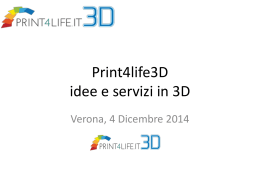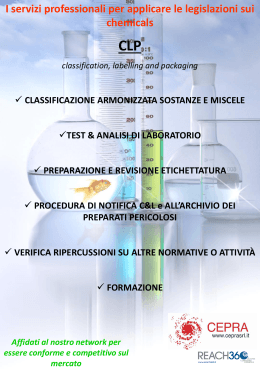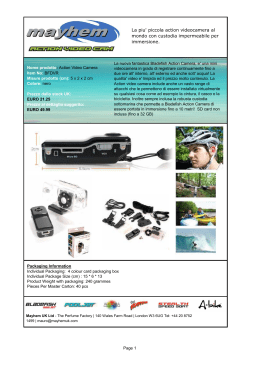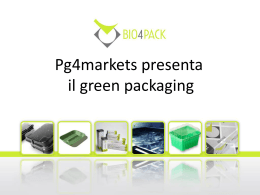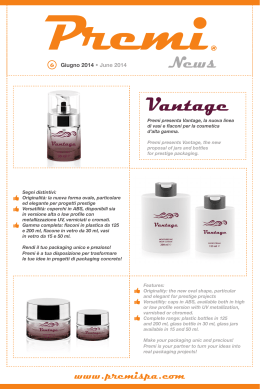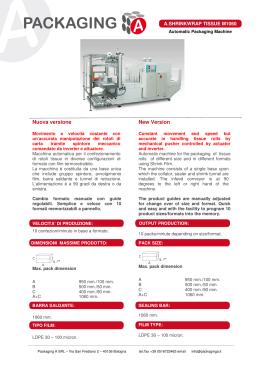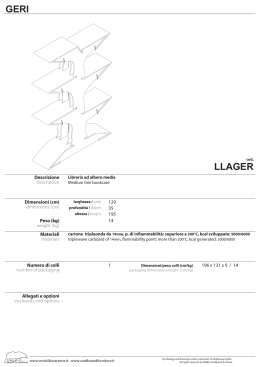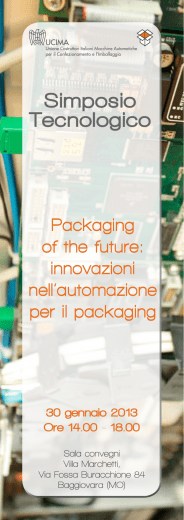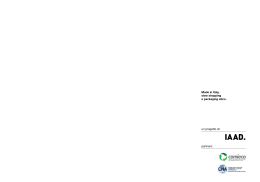Pack and the City L'incredibile ma vero e il credibile ma falso. Quello che potrà essere vero magari in futuro. O anche no. 1. Esistono esempi di definizione per negazione in ogni campo: il personale non docente, per esempio, è quello che suona la campanella; le organizzazioni no profit, invece, sono quelle che non vogliono sentire parlare di cresta sui bilanci; anche disoccupato suona bene, è comunque un’attività. Ma è d’imballaggio che qui si parla; anzi, del rapporto tra contenitori e contenuti, dal più intuitivo al più evoluto: e quindi, negando per definire, è il momento di parlare del topless, “il” senza “il” sopra. Con tanto di designer dedicati ed etichetta, il costume - o l’abito in generale - è il pack più semplice da comprendere, è l’astrazione che ognuno afferra. Ed è perverso, sebbene socialmente più accettabile, considerare come normalità il prodotto confezionato, il corpo ricoperto, quando invece esso nasce (stricto sensu) nudo. La variazione, e pertanto quella deviazione dalla norma che merita una definizione a sé, sembra qui essere l’assenza dell’imballo-costume, benché sia nella realtà un semplice ritorno all’origine; come se il corpo fosse riconoscibile solo topped. O come se tutti noi dicessimo, accaldati e imballati sulla spiaggia: che voglia che ho di bermi un po’ di senzalattina. 20 • 9/07 The incredible but true and the credible but false, that which might be true in the future. Or maybe not. By Junio Caselli and Nicola Romagnani 1.There are examples of defining what something is in terms of what it isn’t in every field: non teaching staff, for instance, are those who ring the school bell; no profit associations, on the other hand , are those which won’t have anything to do with making a profit. Even the word unemployed sounds right. It is an activity anyway. But here we are talking about packaging or the relationship between container and contents, from the most intuitive to the most evolved. Therefore, saying what it isn’t in order to say what it is, it is time to speak of going topless. All decked out in designer labels, bathing costumes - or clothing in general- are the easiest type of pack to understand. It is the abstraction that everyone grasps. And it is perverse, although socially more acceptable, to consider the packaged product, the covered body as normality while it is (strictly speaking) born naked. The variation, and therefore that deviation from the norm which deserves its own definition, appears here to be the absence of the packaging-costume, although in fact it is merely a return to one’s origins. It is as though the body were only recognisable when it is topped. Or as though all of us were to say, boiling hot and wrapped up on the beach: I really fancy an uncanned drink of something. 2. La prima volta è stato avvistato sui camion cicogna lungo le autostrade d’Italia. Rosso. Poi a nascondere nelle piazze il nuovo arrivato, il bebè con i freni a disco. Avanti con il mainstream, dunque: che 500 sia, anche su Pack and the City. Promettiamo che non diremo quant’era bello fare all’amore sui sedili rigidi, con il tettino di tela nera aperto sulle stelle agostane: pare che quella macchina desse più soddisfazioni da ferma che in movimento; e a forza di sentirlo dire, sembra anche a noi di ricordare le pomiciate con la Gazzetta a coprire il lunotto. A noi è il suo confezionamento che piace e interessa. Perché la funzione della scatola è da sempre quella di mostrare le caratteristiche nuove o peculiari del prodotto, esaltarne le qualità. No, ora basta: la vecchia versione rappresentata sul telone è la novità da imballatori visionari. A Torino probabilmente apprezzerebbero un fiammante smartphone avvolto e nascosto da una splendida tutina che richiama un TAC del ‘92, con tutto il carico di emozioni old-fashioned che il suo mezzo chilo si porta dietro. Proiettarsi indietro, e di cinquant’anni, per una nuova percezione del nuovo: non più less is more; ma old is new. 2.It was seen for the first time on the car transporter trailer trucks on the motorways of Italy. Red. Then it was used to conceal the new arrival on billboards. The baby with disc brakes. Let’s be mainstream let the 550 shine forth even in Pack and the City. We promise we won’t say how wonderful it is to make love on the hard seats with the little black canvas roof rolled back so you can see the summer stars. It seems this car provided more satisfaction when it was parked than when it was being driven. And by dint of hearing it said over and over again, we think we remember the hanky-panky with the Gazzetta dello Sport covering the windshield. We like and are interested in its packaging. Because the function of the box has always been to show the new or special features of a product and to enhance its quality. No, that’s enough now. The old version represented on the tarpaulin is the innovation of visionary packagers. In Turin they would probably appreciate a brand new Smartphone cocooned and concealed by a splendid wrapper recalling a ’92 TAC with all the old-fashioned emotional charge its weight of half a kilo carries. Projecting fifty years into the past for a fresh perception of the new: no longer “less is more” but “old is new”. 3. Ma com’è bello scrivere 2.0 dietro a una parola! È il gioco del 2007 (e alcuni volenterosi hanno addirittura appiccicato la release anche al Made in Italy). Il concetto che ne sta alla base non è banale: delegare il contenuto, il prodotto ai consumatori. E tenere per sé solo il contenitore, il pack. Ci piace vedere il mondo come un dualismo tra contenuto e contenitore: è un esercizio interessante, oltre che una deformazione invalidante. Per spiegare dov’è che vediamo questo contrasto manicheo nel web di seconda generazione, possiamo fare questo esempio: stasera ci va una bella margherita di bufala; andiamo dal pizzaiolo accanto, la ordiniamo e quando torniamo, dopo dieci minuti, lui ci mette in mano una bella scatola di cartone ondulato fumante e vuota. Con calma torniamo a casa e ci facciamo la nostra bella pizza, la mettiamo nella scatola e la tagliamo in 5 milioni di fette, tutte uguali, condividendo il piacere 3.What fun it is to write 2.0 next to a word! It’s the entertainment of 2007 (and some enthusiasts have even stuck the release onto Made in Italy too). The root concept is not uninspired. Delegating the content and product to consumers and keeping the container, the pack for oneself. We like to see the world as a dualism between content and container. It is an interesting exercise as well as a debilitating bias. To explain where it is that we see this Manichaean contrast in second generation webs, we can give this example. This evening we fancy a tasty pizza with buffalo mozzarella. We go to the pizzeria next door, order it and, when we go back ten minutes later to pick it up we are handed a lovely, piping hot and empty corrugated cardboard box. We calmly go home and make our own pizza, put it in the box and slice it into 5 million slices, all identical, sharing the pleasure of what it is to be Italian with friends and strangers. This is dell’italianità con amici e sconosciuti. Più o meno è quello che accade quando ci logghiamo su YouTube, con l’unica differenza che un filmato diviso tra milioni di persone non diventa più corto. E che quindi c’è mangiare per tutti. more or less what happens when we log onto YouTube, with the only difference being that a film shared by millions of people is no longer a short. And so there is enough for everyone to eat. 4. Alcuni prodotti non hanno bisogno di packaging primario, ne nascono già forniti. È il caso dei CD o dei libri. Quando dico CD intendo il disco, non la custodia di plastica trasparente: quella è già packaging. Allo stesso modo la copertina del libro è il packaging del libro: come il guscio della tartaruga, il cappuccio della penna, l’elmetto del vigile urbano. Si possono definire packaging indivisibili. Pertanto non c’è alcun bisogno di incellophanare i libri e i CD. È vero che li si protegge dal contatto con i polpastrelli unti o con le mani dei taccheggiatori, ma è anche vero che così si sciupano, alle persone che si lavano le mani e sono soliti pagare i prodotti che si portano a casa, i momenti fondamentali della fruizione/godimento dell’oggetto. Quello in cui, ancora nel negozio, si apre la custodia del CD e si guarda quanto è spesso il libretto con i testi o se c’è una foto sexy della cantante; quello in cui si sfoglia il libro per cercare e non trovare la frase che ci convinca a non poter fare a meno proprio di quel libro, perché la quarta di copertina non basta; e anche il momento in cui, a casa, volendo godere di quel bene, non lo si riesce mai ad aprire se non usando un coltello da ostriche o un tagliaunghie. 4. Some products have no need of primary packaging. They are born with it. This is the case of CDs or books. When I say CD I mean the disc not the transparent plastic case. That is the packaging. In the same way the jacket of a book is the packaging of the book: like the shell of a tortoise, the top of a pen, the helmet of a traffic policeman. They may be defined as inseparable packaging. Therefore, there is no need to wrap books and CDs in cellophane. It is true that it protects them from greasy fingers or shoplifters but it is also true that it spoils the enjoyment for those people who wash their hands or usually pay for the products they take home. That moment in the shop when you open the case to see how thick the leaflet containing the lyrics is or if there is a sexy photo of the singer. The moment when you browse through a book looking for and not finding that sentence which persuades you you cannot do without it because the back cover isn’t enough to convince you. And it is also the moment when, once you are home, wanting to enjoy what you’ve purchased, you cannot get it open without using an oyster shucker or a set of nail clippers. Junio Caselli e Nicola Romagnani di Archita, studio di consulenza su packaging e tecnologie industriali, si occupano di tecnologie alimentari, studio dei materiali e problem solving, oltre che di imballaggi. Hanno entrambi trent'anni e la loro sede è a Bientina (PI). Altri loro interventi su: widethinkingpeople.blogspot.com. Junio Caselli and Nicola Romagnani of Archita, are consultants in industrial packaging and technologies, dealing with food technology, the study of materials and problem solving, as well as packaging. They are both thirty years of age and their office is in Bientina (PI). You can find more of their articles on widethinkingpeople.blogspot.com.
Scarica
